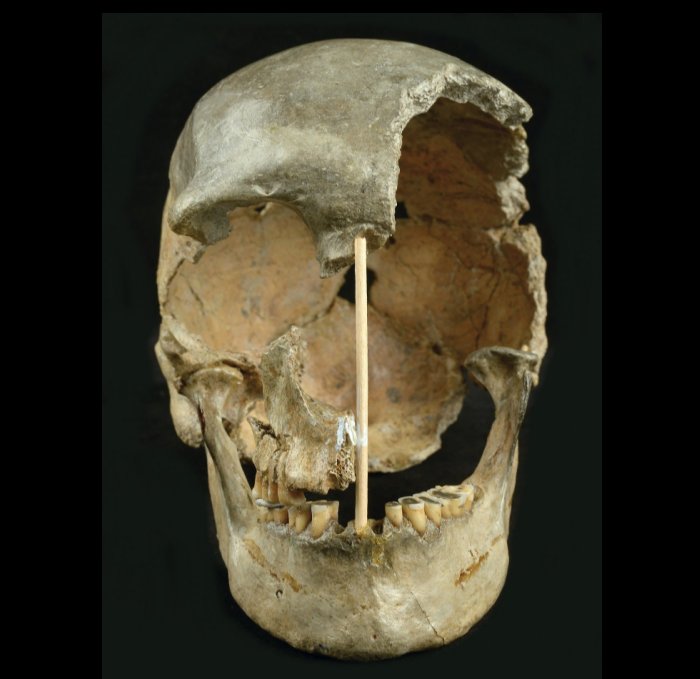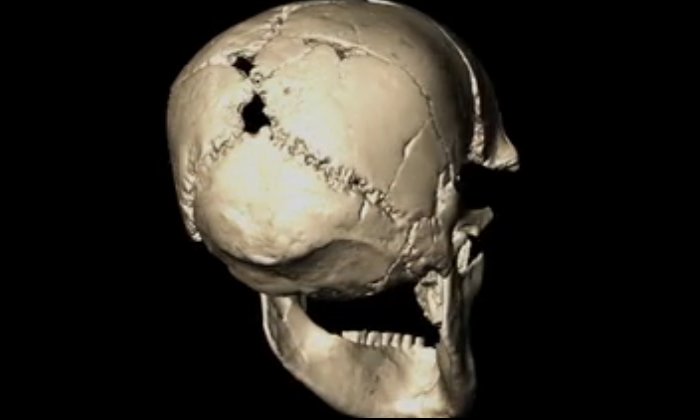Conny Waters – AncientPages.com – Now, an international team of researchers analyzed the genome of the skull and reports what is likely the oldest reconstructed modern human genome to date.
The segments of Neanderthal DNA in its genome were longer than those of the Ust’-Ishim individual from Siberia, the previous oldest modern human sequenced, suggesting modern humans lived in the heart of Europe more than 45,000 years ago.
 Initial attempts to date Zlatý kůň based on the shape of her skull suggested she was at least 30,000 years old. Researchers now believe she lived more than 45,000 years ago. Martin Frouz
Initial attempts to date Zlatý kůň based on the shape of her skull suggested she was at least 30,000 years old. Researchers now believe she lived more than 45,000 years ago. Martin Frouz
An almost complete skull of a woman known to researchers as Zlatý kůň (golden horse in Czech) – and now stored in the National Museum in Prague – was discovered in the early 1950s.
Analysis suggests that she was part of a population that formed before the populations that gave rise to present-day Europeans and Asians split apart.
Ancient DNA from Neandertals and early modern humans have recently shown that the groups likely interbred somewhere in the Near East after modern humans left Africa some 50,000 years ago. As a result, all people outside Africa carry around 2% to 3% Neandertal DNA.
In modern human genomes, those Neandertal DNA segments became increasingly shorter over time and their length can be used to estimate when an individual lived. Archaeological data published last year furthermore suggests that modern humans were already present in southeastern Europe 47-43,000 years ago, but due to a scarcity of fairly complete human fossils and the lack of genomic DNA, there is little understanding of who these early human colonists were – or of their relationships to ancient and present-day human groups.
 Image credit: Martin Frouz
Image credit: Martin Frouz
A recent anthropological study based on the shape of Zlatý kůň’s skull showed similarities with people who lived in Europe before the Last Glacial Maximum – at least 30,000 years ago – but radiocarbon dating produced sporadic results, some as recent as 15,000 years ago. It wasn’t until Jaroslav Brůžek from the Faculty of Science, Prague and Petr Velemínský of Prague’s National Museum collaborated with the genetics laboratories of the Max Planck Insтιтute for the Science of Human History that a clearer picture came into view.
“We found evidence of cow DNA contamination in the analyzed bone, which suggests that a bovine-based glue used in the past to consolidate the skull was returning radiocarbon dates younger than the fossil’s true age,” says Cosimo Posth, co-lead author of the study, and currently Professor of Archaeo- and Palaeogenetics at the University of Tübingen.
“The results of our DNA analysis show that Zlatý kůň lived closer in time to the admixture event with Neanderthals,” says Kay Prüfer, co-lead author of the study.
The scientists were able to estimate that Zlatý kůň lived approximately 2,000 years after the last admixture. Based on these findings, the team argues that Zlatý kůň represents the oldest human genome to date, roughly the same age as – if not a few hundred years older than – Ust’-Ishim.
“It is quite intriguing that the earliest modern humans in Europe ultimately didn’t succeed! Just as with Ust’-Ishim and the so far oldest European skull from Oase 1, Zlatý kůň shows no genetic continuity with modern humans that lived in Europe after 40,000 years ago,” says Johannes Krause, senior author of the study and director at the Max Planck Insтιтute for Evolutionary Anthropology.
One possible explanation for the discontinuity is the Campanian Ignimbrite volcanic eruption roughly 39,000 years ago, which severely affected climate in the northern hemisphere and may have reduced the survival chances of Neanderthals and early modern humans in large parts of Ice Age Europe.
As advances in ancient DNA reveal more about the story of our species, future genetic studies of other early European individuals will help to reconstruct the history and decline of the first modern humans to expand out of Africa and into Eurasia before the formation of modern-day non-African populations.
Paper
Written by Conny Waters – AncientPages.com Staff Writer





